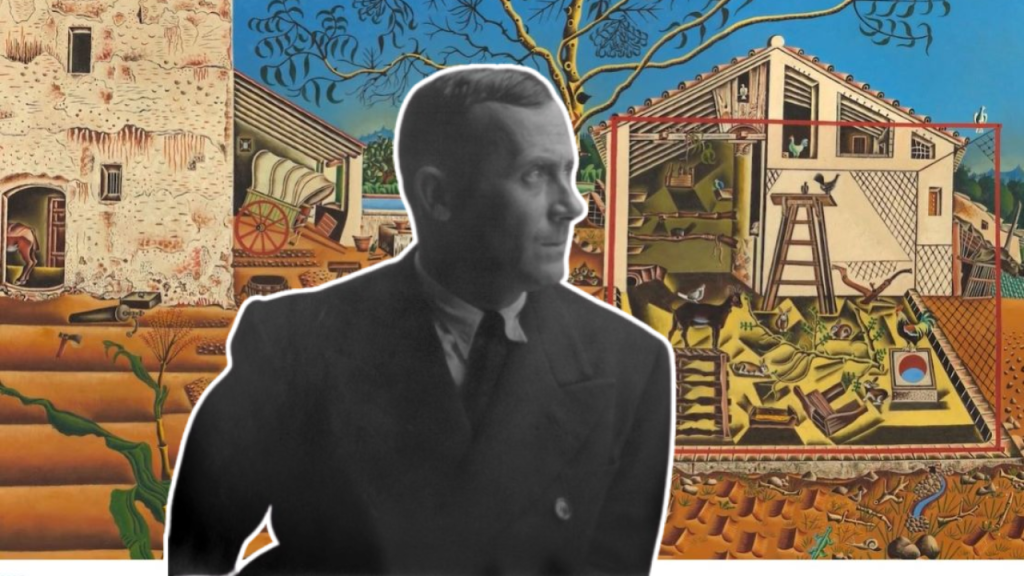Joan Miró, an artist of the 20th century, left an incredible mark on the art world with his unique style and imaginative creations. Born in Barcelona in 1893, Miró’s works continue to captivate audiences worldwide with their vibrant colours, abstract forms, and playful compositions. while Joan Miró’s works are diverse and encompass various themes and styles throughout his career, they consistently evoke a sense of whimsy, surrealism, and a deep connection to his Catalan heritage. Miró’s paintings often feature vibrant colours, playful shapes, and symbolic imagery that invite viewers into a world where reality blends with the imagination. From early masterpieces like The Farm, which depicts a dreamlike Catalan farmhouse, to later works such as Harlequin’s Carnival and Woman And Birds In The Night, Miró’s art continually explores themes of the subconscious, the cosmos, and the essence of life itself. His legacy as a pioneer of modern art is characterised by his ability to provoke emotion and introspection through his bold use of abstraction and symbolism, making each encounter with his art a journey into the depths of creativity and human experience.

Understanding Joan Miró’s Artistic Vision
Joan Miró’s paintings, ranging from surreal landscapes to whimsical abstractions, reflect his deep connection to his Catalan roots and his fascination with the subconscious mind. His mastery lies in blending elements of cubism, surrealism, and expressionism into a distinctive visual language that remains influential to this day.
Key Joan Miró Paintings
1. The Farm: Painted in 1921-1922, The Farm is considered Miró’s breakthrough masterpiece, depicting a Catalan farmhouse in a dreamlike setting. Its bold colours and simplified forms foreshadow his later abstract style.

2. The Hunter: Reflecting Miró’s interest in primal themes, The Hunter (1924) portrays a mythical figure in a primitive landscape, showcasing his symbolic approach to art.

3. Harlequin’s Carnival: Created in 1924-1925, Harlequin’s Carnival features Miró’s playful use of symbols and colours, evoking the festive spirit of traditional carnivals with a surreal twist.

4. The Tilled Field: Painted in 1923-1924, The Tilled Field exemplifies Miró’s transition towards abstraction, using organic shapes and symbols to evoke the essence of rural life.

5. Woman And Birds In The Night: This 1968 painting showcases Miró’s mature style, where symbols like birds and stars populate a dreamy, cosmic landscape, inviting viewers into a poetic narrative.
Iconic Themes and Inspirations
Joan Miró’s fascination with the subconscious and the natural world is evident throughout his oeuvre. His paintings often feature celestial bodies, fantastical creatures, and everyday objects imbued with symbolic meaning. This blend of the real and the imagined invites viewers to interpret his works through their own perspectives, making each encounter with Miró’s art a deeply personal experience.
Legacy and Influence
Miró’s influence extends beyond his paintings to sculpture, ceramics, and even public art installations. His bold experimentation with form and colour continues to inspire contemporary artists and art enthusiasts alike, reaffirming his status as a pioneer of modern art.
Conclusion
Joan Miró’s artistic journey, marked by innovation and creativity, continues to resonate with audiences globally. Through his masterpieces like The Farm, The Hunter, and Harlequin’s Carnival, he invites us into a world where imagination knows no bounds. Explore the vibrant universe of Joan Miró’s art and discover why his paintings remain timeless symbols of artistic expression and creativity. In summary, Joan Miró’s legacy endures through his ability to challenge artistic norms and provoke thought, ensuring his place in the pantheon of great artists.
Mastering Wakanda’s Majesty: A Comprehensive Guide to Drawing the Black Panther






